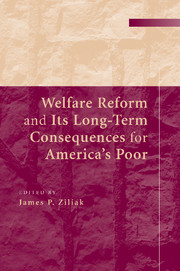Book contents
- Frontmatter
- Contents
- Contributors
- Preface
- Introduction
- 1 What We Know, What We Don't Know, and What We Need to Know about Welfare Reform
- 2 Welfare Reform and the Level and Composition of Income
- 3 How Have Expansions in the Earned Income Tax Credit Affected Family Expenditures?
- 4 How Families Are Doing Nine Years after Welfare Reform: 2005 Evidence from the Three-City Study
- 5 The Impact of Welfare Reform on Leaver Characteristics, Employment, and Recidivism
- 6 A Reexamination of the Impact of Welfare Reform on Health Insurance Among Less-Skilled Women
- 7 How Welfare Policies Affect Child and Adolescent School Performance: Investigating Pathways of Influence with Experimental Data
- 8 The Effects of Welfare and Child Support Policies on the Incidence of Marriage Following a Nonmarital Birth
- 9 Welfare Reform and Health among the Children of Immigrants
- 10 Mismatches and Unmet Need: Access to Social Services in Urban and Rural America
- Index
Preface
Published online by Cambridge University Press: 21 January 2010
- Frontmatter
- Contents
- Contributors
- Preface
- Introduction
- 1 What We Know, What We Don't Know, and What We Need to Know about Welfare Reform
- 2 Welfare Reform and the Level and Composition of Income
- 3 How Have Expansions in the Earned Income Tax Credit Affected Family Expenditures?
- 4 How Families Are Doing Nine Years after Welfare Reform: 2005 Evidence from the Three-City Study
- 5 The Impact of Welfare Reform on Leaver Characteristics, Employment, and Recidivism
- 6 A Reexamination of the Impact of Welfare Reform on Health Insurance Among Less-Skilled Women
- 7 How Welfare Policies Affect Child and Adolescent School Performance: Investigating Pathways of Influence with Experimental Data
- 8 The Effects of Welfare and Child Support Policies on the Incidence of Marriage Following a Nonmarital Birth
- 9 Welfare Reform and Health among the Children of Immigrants
- 10 Mismatches and Unmet Need: Access to Social Services in Urban and Rural America
- Index
Summary
Taking stock of the research on the effects of the 1996 welfare reform in the fall of 2005, it became abundantly clear that as we neared the tenth anniversary of its passage, we knew comparatively little about the longerterm consequences of the reform for America's poor. The lucid surveys by Blank (2002) and Moffitt (2003), followed by the meta-analysis by Grogger and Karoly (2005), summarized the research using experimental and nonexperimental data from the “welfare waiver” era spanning 1990 to 1995 and data from the first four years postreform through 2000. The late 1990s was a period of great prosperity and relative peace for the nation, and thus many of the gains of the poor uncovered in the research were undoubtedly fostered by the strong economy. Since the business cycle peak of 2000, the country has experienced a recession, the 9/11 terrorist attacks, two ongoing wars in Afghanistan and Iraq, rising poverty, declining health insurance coverage, a series of devastating hurricanes, and stagnant real wages. As this book goes to press, the world is in the midst of the greatest financial crisis since the Great Depression. How these developments interact with public policies such as welfare reform and the Earned Income Tax Credit to affect the lives of the poor had not been explored nearly to the extent that the pre-2000 experience would dictate.
- Type
- Chapter
- Information
- Publisher: Cambridge University PressPrint publication year: 2009

